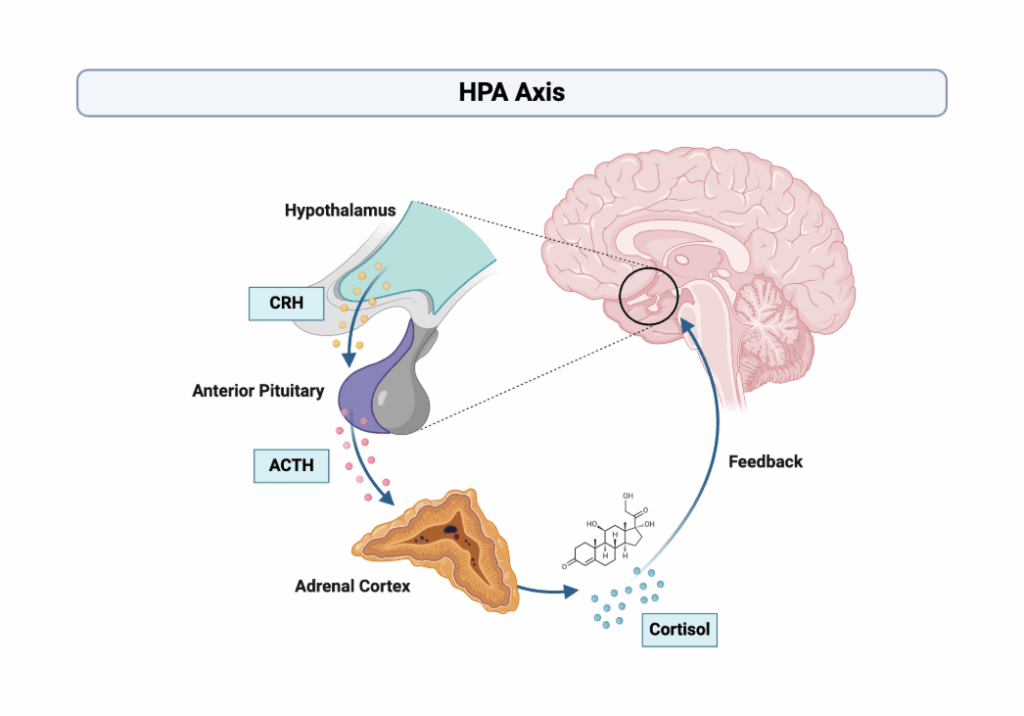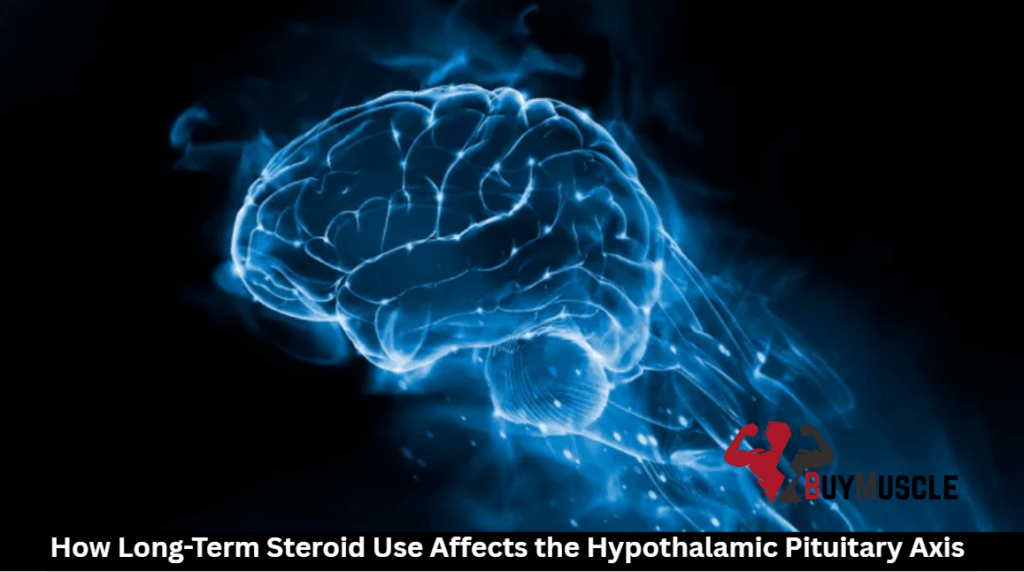Long-term steroid use suppresses your Hypothalamic Pituitary Axis by mimicking natural cortisol, causing your brain to reduce hormone production. It leads to decreased CRH from your hypothalamus and reduced ACTH from your pituitary gland. Over weeks to months, your adrenal glands atrophy, resulting in symptoms like fatigue, weakness, and poor stress response. Recovery varies from months to over a year.
Physiological Mechanisms of HPA Axis Suppression by Exogenous Steroids
When you introduce synthetic steroids into your body for extended periods, they fundamentally disrupt the delicate signaling pathways of the hypothalamic-pituitary-adrenal (HPA) axis. These exogenous steroids mimic cortisol’s molecular structure, flooding receptor sites throughout your system.
Your brain interprets this abundance as a signal that natural production isn’t needed. It triggers negative hormonal feedback loops, instructing your hypothalamus to reduce corticotropin-releasing hormone (CRH) secretion. Consequently, your pituitary gland decreases ACTH production, which normally stimulates your adrenal glands to release cortisol.
Over time, this chronic suppression leads to atrophy of your adrenal cortex as it’s no longer regularly stimulated by ACTH. Your body becomes dependent on external steroid supply, losing its natural ability to respond to stress through appropriate cortisol regulation.

Timeline of Neuroendocrine Adaptation to Long-Term Steroid Therapy
The progression of HPA axis suppression follows a predictable but individually variable timeline when patients undergo long-term steroid therapy. Within days of starting treatment, your pituitary gland reduces ACTH production in response to the excess steroid levels it detects. By weeks 2-4, significant suppression becomes evident as your adrenal glands begin to atrophy from lack of stimulation.
After 1-3 months of continuous use, you’ll experience a pronounced hormonal imbalance as your natural cortisol production dramatically decreases. The longer you remain on steroids, the more profound this suppression becomes.
Recovery timelines vary considerably. Some patients regain normal function within months after discontinuation, while others may require a year or longer for their HPA axis to normalize, especially following years of steroid dependency.

Clinical Manifestations of HPA Axis Dysfunction After Prolonged Steroid Use
Patients who undergo extended steroid therapy often develop a distinctive set of clinical manifestations as their HPA axis function deteriorates. You’ll typically notice fatigue, weakness, and joint pain as your body’s natural hormone production becomes suppressed. When ACTH levels remain chronically low, your adrenal glands shrink and lose their capacity to respond properly to stress.
This dysfunction manifests in unexplained weight loss, decreased appetite, nausea, hypoglycemia, and hypotension. During withdrawal, you may experience more severe symptoms like extreme fatigue, muscle pain, and mood disturbances as your body struggles with adaptation to functioning without exogenous steroids. The severity of these manifestations depends on the duration of steroid use, dosage, and individual factors.
Some patients require months for complete recovery, while others may face permanent HPA axis impairment.

Strategies for Monitoring and Preventing HPA Axis Suppression
Effective monitoring and prevention of HPA axis suppression require vigilant medical oversight and strategic treatment planning. Your doctor should regularly assess your endocrine system functioning through morning cortisol and ACTH stimulation tests to detect early signs of dysregulation.
To minimize suppression risks, you’ll benefit from using the lowest effective steroid dose for the shortest possible duration. Alternate-day therapy often helps maintain normal stress response capabilities while managing your condition. Consider non-steroid treatments when appropriate, and never abruptly discontinue your medication.
During therapy, support your body’s natural regulation processes by maintaining consistent sleep patterns and managing psychological stress. If long-term steroid treatment is unavoidable, work with an endocrinologist to develop personalized monitoring protocols and protective strategies that safeguard your HPA axis function.
Recovery Patterns and Rehabilitation of the HPA Axis Following Steroid Withdrawal
After discontinuing long-term steroid therapy, your hypothalamic-pituitary-adrenal (HPA) axis typically follows a predictable yet individually variable recovery pattern. The resumption of normal ACTH production is your body’s first step toward independence from external steroids. This recovery timeline varies markedly. Some patients regain function within weeks, while others face months or even years of rehabilitation.
Your dependence level correlates directly with the duration and dosage of steroid use. The longer your treatment lasted, the more pronounced your HPA suppression likely became. During recovery, you’ll need regular hormone level monitoring as your system gradually reawakens.
Physicians often implement supportive therapies and stress-dose protocols to prevent adrenal crisis while your natural production slowly resumes. Patience becomes essential, as premature cessation of support can trigger dangerous physiological consequences.
Frequently Asked Questions
Are Genetic Factors Involved in Individual HPA Axis Recovery Rates?
Yes, your genetics greatly influence HPA axis recovery rates. You’ll experience different recovery timelines based on your genetic makeup, which affects hormone receptor sensitivity, metabolic efficiency, and overall endocrine system resilience.
How Do Different Steroid Delivery Methods Affect HPA Axis Suppression?
Your HPA axis suppression varies by steroid delivery method. Oral steroids cause more suppression than topical or inhaled forms. Systemic routes (oral, IV) affect the axis more severely than localized applications.
Can Nutritional Interventions Support HPA Axis Function During Steroid Use?
You can support HPA axis function with adequate protein, vitamin C, B vitamins, magnesium, and zinc. These nutrients help minimize suppression and maintain adrenal health while you’re taking steroids, though they won’t prevent it entirely.
Do Childhood Steroid Exposures Create Different Long-Term HPA Effects Than Adult Use?
Yes, childhood steroid exposures typically create more severe and lasting HPA disruptions than adult use due to your developing neuroendocrine system. You’ll face potentially permanent alterations to growth, development, and future stress responses.
How Do Concurrent Medications Influence Steroid-Induced HPA Axis Suppression?
Certain medications can worsen your steroid-induced HPA suppression. CYP3A4 inhibitors like ketoconazole increase steroid bioavailability, while drugs affecting cortisol metabolism or competing for receptor binding can intensify or prolong suppression effects.








